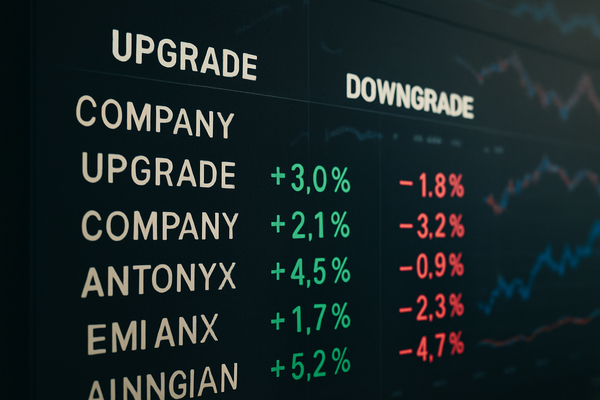
Apple (NASDAQ:AAPL) delays and chip demand collide in investor flows
Apple (NASDAQ:AAPL) flagged a delay to the next iPhone Air and partners with Globalstar (NASDAQ:GSAT) on expanded satellite features, reshaping short-term handset demand while underscoring longer-term connectivity trends. This matters now because holiday-season buying and AI-driven infrastructure orders are moving capital between consumer hardware, chipmakers, and satellite services. In the short term, weaker device cadence weighs on component orders in the U.S. and Europe. Over the long term, rising data-center and satellite services demand accelerates spending across Asia and emerging markets. Compared with prior iPhone cycles, the market is rebalancing faster—rewarding AI infrastructure winners and penalizing near-term product hiccups.
Market Pulse Check
Investors rotated money into AI infrastructure and chip suppliers while punishing companies facing execution or legal noise. Nvidia (NASDAQ:NVDA) and Microsoft (NASDAQ:MSFT) led a risk-on move after signs of renewed liquidity and a partial end to the government shutdown, driving tech-heavy indices higher. Meanwhile, CoreWeave (NASDAQ:CRWV) and some hyperscaler suppliers saw volatile flows after delayed projects and cautious guidance.
- NVIDIA’s momentum is driving data-center demand and ETF flows into semiconductor exposure.
- Taiwan Semiconductor Manufacturing (NYSE:TSM) posted record October sales—NT$367.47 billion (~US$11.86 billion)—but the 17% YoY rise marked the slowest pace since early 2024, prompting mixed positioning.
- Broadcom (NASDAQ:AVGO) and other AI-link names attracted institutional buying, while CDW Corp’s downgrade tightened positioning in some distributor chains.
Net: fresh capital chased scale and AI exposure. Other pockets of selling reflected nearer-term execution risk and guidance cuts.
Analyst Convictions — upgrades, downgrades and sentiment gaps
Analysts moved tactically while markets digested earnings and guidance. Barclays upgraded KLA (NASDAQ:KLAC) and BNP Paribas highlighted upside for Analog Devices (NASDAQ:ADI). At the same time, Rothschild & Co trimmed HubSpot (NYSE:HUBS), and CDW (NASDAQ:CDW) was downgraded to Hold. These calls reveal two forces: valuation re-rating toward durable earnings, and caution where execution or secular exposure looks weaker.
Key contrasts:
- Upgrades focused on industrial tech and equipment leaders with improving margins and visible order backlogs (KLAC, ADI).
- Downgrades hit companies with softer near-term demand or thinner margin visibility (CDW, HUBS).
Historically, upgrades concentrated in equipment and materials precede capex cycles. Here, analysts are betting that AI-driven capex will sustain demand for tools and components even if near-term seasonal demand softens.
Risk Events vs. Expansion — operational setbacks and capacity bets
Operational risk and expansion stories ran in parallel. CoreWeave (NASDAQ:CRWV) saw its stock wobble after delays to a data-center buildout and a jittery earnings reaction. By contrast, Tower Semiconductor (NASDAQ/TASE:TSEM) raised Q4 guidance and flagged capacity expansion, sending shares to multi-year highs. TSMC’s (NYSE:TSM) October sales set a monthly record even as growth cooled to 17% YoY, illustrating how scale can mask margin and cycle shifts.
Examples of divergence:
- Delayed projects: CoreWeave’s setbacks tightened expectations for near-term revenue and amplified sensitivity to capex pacing.
- Capacity expansion: Tower Semiconductor and select equipment vendors are booking orders and enlarging capacity, betting on sustained AI demand.
The net effect: investors rewarded visible, funded expansion and punished timing uncertainty. That bifurcation widened sector dispersion this earnings season.
Leadership and Fundamentals — board moves, exec exits and price-action gaps
Leadership moves altered narratives even when fundamentals stayed intact. Intel (NASDAQ:INTC) named Dr. Craig H. Barratt to its board and the CEO assumed direct oversight of AI efforts after a CTO departure — a governance response to execution priorities. Jamf (NASDAQ:JAMF) reported strong Q3 results and Life360 (NASDAQ:LIF) delivered record quarterly growth alongside an acquisition, showing fundamentals that contrast with headline-driven selloffs at other names.
Where price and fundamentals diverge:
- Apple (NASDAQ:AAPL) faces a product delay but retains a large services franchise and strong installed base—stock reaction reflected timing rather than a structural hit.
- TSMC (NYSE:TSM) posted record monthly sales but with slowing growth; the market parsed capacity and unit economics differently than headline revenue gains suggested.
Investor takeaways: leadership changes and governance signals now matter as much as order books. Management moves often re-rate perceived execution risk even when revenue trends remain positive.
Investor Sentiment
Institutional flows favored scalable AI exposure. Hedge funds and long-only managers added positions in large-cap chip and software names. Retail interest concentrated in high-beta AI names such as Nvidia (NASDAQ:NVDA) and Palantir (NYSE:PLTR), which rallied on renewed risk appetite. By contrast, retail and some mutual funds trimmed positions in names exposed to consumer hardware cycles and project timing uncertainty.
Evidence of divergence:
- Institutional buying: Broadcom (NASDAQ:AVGO) and other AI-linked dividend growers saw progressive institutional accumulation.
- Retail-led volatility: CoreWeave (NASDAQ:CRWV) and Palantir (NYSE:PLTR) displayed outsized intra-day moves tied to headlines and social chatter.
Valuation disconnects persisted. A subset of firms showed strong fundamentals but lackluster share performance, while several momentum names commanded premium multiples despite execution questions. That split is driving active rebalancing across ETFs and specialty funds.
Investor Signals Ahead
These contrasts — upgrades versus downgrades, delayed projects versus capacity expansion, and governance shifts versus steady fundamentals — set the stage for a month of sector jockeying. Investors are likely to favor companies that combine visible order backlogs, clear capacity commitments, and stabilizing leadership. At the same time, headline risk will keep volatility high for firms tied to project timing and product cycles.
For now, capital is flowing to scale: data-center and AI infrastructure winners are attracting fresh allocations, while firms with near-term execution risks face higher discounting. Over the coming month, this repricing could reshuffle relative performance across large-cap tech, equipment suppliers, and specialized services.












